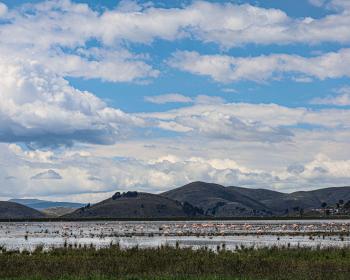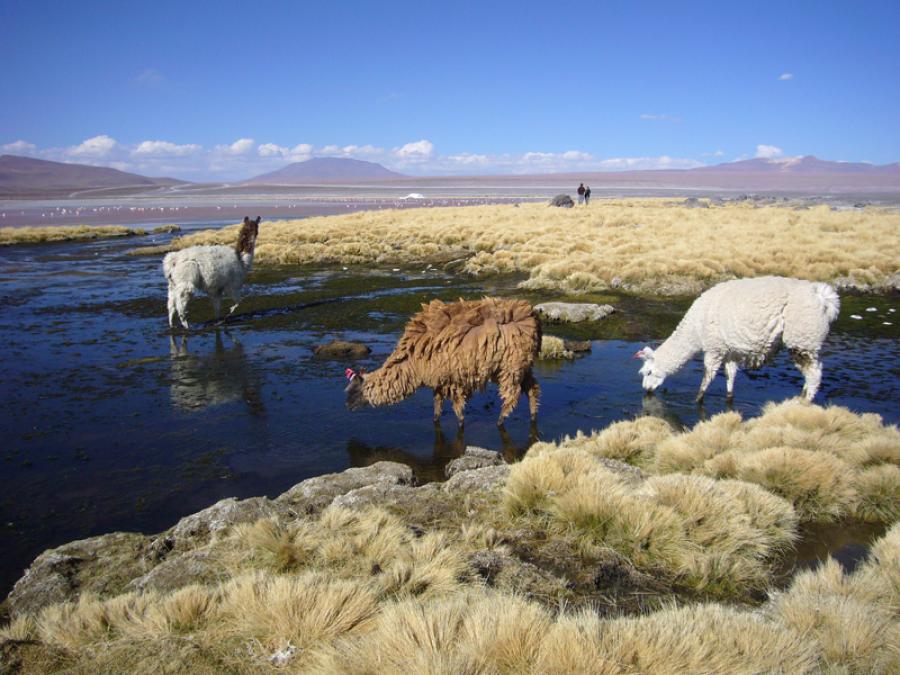Carmen Pereira de Noe is president of the Center for Indigenous Women of Beni (CMIB), part of the Indigenous Organization of the Beni Region (CPIB). Beni is located in the northeast of Bolivia. CPIB receives support from the Confederation of Indigenous Peoples of the Bolivian Oriane, which is partially funded by Cultural Survival. This article derives from a report that Pereira de Noe prepared for Cultural Survival.
The Department of Beni, spanning approximately 133,500 square miles and home to 215,400 people, is an economically depressed area, where underdevelopment and poverty affect a great part of the population. After 500 years, the mechanisms and forms of oppression that have subordinate Indians and usurped indigenous territories continue. The injustices we face include usurpation of our territories and extermination of the natural resources found here, maltreatment of our women and children by unscrupulous merchants and religious sects, and enslavement of our native authorities and governments.
Today, exact data on the native population of Beni is not available, as this has never been an important concern for the Bolivian state. But we know through polls and partial studies that we indigenous people number more than 60,000 throughout the various towns in the region, and include over 20 tribes, such as the Mojeño, the Chimane, and the Pacauara.
When we speak about living conditions, about improving the quality of life, about hunger and poverty, we speak of defending our children and defending the future of our families and communities. Women and children suffer the most from problems affecting all of Beni's native peoples, and the situation worsens continually. Indigenous children have been abandoned by the government. Health and education services do not come to the indigenous communities and settlements. More than 90 percent of these communities receive no medical services. The levels of disease and death are so high that in some villages children under the age of three aren't counted as part of the population, and more than 40 percent of children die in each indigenous family. This is true even in the region populated by the Chimane people, who suffer less sickness than others.
Less than two hours from the capital of Beni, no health stations exist. There is only a health promoter without medicines or a state salary. It is easy to imagine what happens in more isolated zones accessible only by several days' travel on foot.
Education services are no better. To use just one example, at least 35 percent of the people in Carmen del Aperecito has had no schooling whatsoever, and less than half of the children manage to reach the third grade. A few communities have a small rural school, constructed by the village, where there is usually only one teacher who doesn't receive a state salary. in most of the communities, school don't exist at all. We don't know what will happen if funding for schools and education disappears.
Cases of violence and abuse of rural women and children are recurrent and always go unpunished. We have the case of the murder of a seven-year-old Indian child, an example of the political terror unleashed by the usurpers of the land. More than a year has passed and still there is no justice. We also have reports of violations against women and children in the indigenous communities by disguised delinquents that come during the night or take advantage of the communities' vulnerability when the men are in the forest.
The situation of native women and children in urban centers, such as the capital of Beni, is no different. There we experience maltreatment, exploitation in the workplace, and over-crowded living conditions. For example, 2,604 Mojeña de Trinidad people in the capital have been forced onto about two acres of land. The 45 houses there can only accommodate 480 people, or 11 percent of the city's indigenous population. The rest are forced to live in marginal neighborhoods because they don't fit in the small communal property.
In the urban centers, women carry the heaviest burden. They are obliged to go to the streets in search of an income for the family, leaving their children, many of whom also must work. Often the women must make very unequal trades of valuable items for necessary articles. For example, we find exchanges of a lizard skin for a small fishhook or five chickens for one large box of matches.
These are the conditions that most native peoples in Beni have learned to live with. Elsewhere in Bolivia, native peoples have succeeded in returning to their original lands and now fight for recognition of their rights to the territory.
WOMEN'S ROLE
Native resistance has been expressed throughout history in different ways, and women have played a role in each of the moments of resistance.
Today, perhaps, women's presence is at its greatest and most influential. In recent years, with the increase of business activities, the concentration of land and natural resources in few hands, and the crisis that affects the popular majority, a new movement of indigenous resistance in Beni has been initiated. We now struggle for such clear objectives as territorial rights, indigenous autonomy, and our natural rights. We are concerned about the absence of group rights for our villages and of specific laws that guarantee our individuals rights as native peoples in the constitution of Bolivia. Recovering our own territories and our autonomy would permit us to have self-determination and to gain respect for the dignity of our people.
On the seventh of March, 1987, the Center for Cabildos Mojeños (CCIM) was created. This organization has joined all the Mojeño people for the first time, though primarily those in the Beni region. The CCIM coordinates organizational work among Mojeña communities, visiting, analyzing, and collecting reports and requests.
Our intense organizational work has resulted in many events and organizations. In 1987, we held the First Congress of Native Mojeña Women, from which emerged the Center of Native Moje4a Women, an organization dedicated to organizing, recovering, and fortifying Mojeña people's ethnic and cultural identity. Out of that work came the First Congress of Indigenous Peoples of Beni in 1984 in which all of the villages in the region participated.
From the congress, the Indigenous Organization of the Beni Region emerged. But since this organization did not include a plan for a women's network, women carved out their own space in the Benian Indian Movement by creating the Center for Indigenous Women of Beni (CMIB). This gives a beginning to a unified and solid fight for territory and collective rights, centering attention on the zones of greatest conflict where concrete land demands already exist. This process culminated in the 1990 historic March for Territory and Dignity.
The March for Territory and Dignity bore the tracks of women and children from various native village of Beni, including 125 women, 47 children younger than school age, 12 infants, and many pregnant women. They ascended the Andes, defying the cold, rains, and torment of an interminably long walk, to spread the voices of the native peoples of Beni. The march expressed the feeling of all Bolivian people. The Indians pledged themselves to this trek and received support from both popular organizations and institutions that assist native peoples. These supporters obtained recognition of native territories in four regions for various native groups of the Beni from the Bolivian government. Most importantly, they won respect for indigenous people.
With the march, a new stage in the movement of Indian resistance began: the consolidation of gained territory and indigenous rights under the law. Beni activists have been struggling with this process for over a year, but the complete adoption of decrees recognizing native territories has still not been achieved. Much remains to be accomplished, and women are continuing their roles for the total liberation of the native peoples of Beni and the rest of Bolivia. Work still must be done to gain legal rights, but we believe that our perspective is better because we have succeeded in organizing and gaining respect for ourselves.
Legislation recognizing our rights is still pending. The International Labor Organization Convention 169 will be our instrument to create an opening. [The convention deals with the rights of indigenous and tribal peoples and can be used to establish a legal precedent for those rights.] However, the Bolivian Parliament still doesn't recognize our right to territories and the use of resources, our full autonomy, and the validity of our natural rights as the first inhabitants of the land. We are struggling to make the political state incorporate the rights of indigenous people into its constitution.
In the CMIB, we are working to mobilize women in the villages that still are not organized. We actively participate in efforts to consolidate and gain control over territory, participating in the meetings of the original authorities of each territory and in training courses.
There is already effective participation in the control of business activity inside our territories. Recently, women have been vital in confiscating chain saws used against our forests. In the territories, women will also take responsibility for directing boarding schools for our children and for setting up handicrafts production projects. And as reproducers of the language and culture, women occupy the fundamental role in strengthening our ethnic and cultural diversity.
For the people that haven't yet gained recognition for their own territories, the struggle has just begun, and women are present.
Projects for the Future
Country: Chile
Project : Promoting Development in Quepuca Ralco
Lonko Kil pan promotes ecologically and cultural sound development. A Mapuche service, consulting, and research institution, it works in 31 indigenous communities and is composed of professionals and vocationally rained people of Mapuche descent who have a variety of experiences in ethnodevelopment, particularly rural development.
Since 1985, Lonko Kil pan has concentrated its work in Mapuche communities. As on 1991, it has worked with the Pehuenche, a smaller group related to the Mapuche, in the Upper Bío-Bío region in the community of Quepuca-Ralco. Some 600 Pehuenche families live in this region in seven communities.
In response to government plans to build hydroelectric plants in the Upper Bío-Bío, the indigenous development project will focus on natural-resource management, in particular crop diversification, reforestation, and soil conservation. The project will also address the effects of the hydroelectric plants on the Pechuenche people. The plants will lead to the creation of artificial lakes and a population increase,both of which will affect the environment and the local people. Lonko Kil pan plans to defend the civil, legal, territorial, and human rights of the Pehuenche, as well as support Pehuenche organizing to evaluate the impact of building the hydroelectric plants.
Address: Sociedad Lonko Kil pan, Balmaceda No. 1633, Oficina 8, Temuco, Chile
Article copyright Cultural Survival, Inc.


